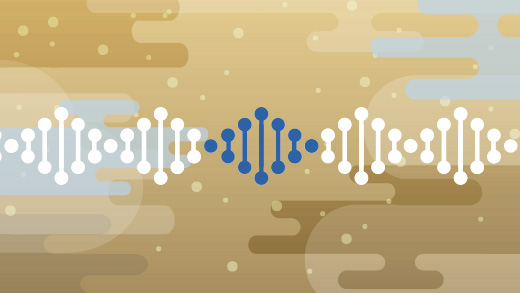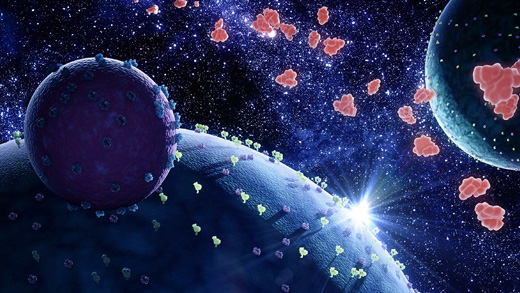Understanding Appetite
Using HiBiT protein tagging to understand the biology behind our desire for food
The smell of freshly baked bread. The sound of crispy bacon sizzling in a pan. The sight of plump, juicy grapes hanging on a vine. What makes us hungry? What satisfies our hunger? On one level, the answers to these questions are different for all of us—and totally dependent on culture and personal tastes. But at the molecular level, the biological pathways controlling the desire to eat or stop eating are fundamentally common to us all.
The complex cellular processes controlling appetite begin when hormones such as ghrelin, melanocortin and others interact with cell surface receptors in the brain, initiating signaling pathways that stimulate or suppress appetite and prepare the body for digestion, ultimately resulting in the storage or release of energy from food.
It is in the intricate details of these pathways that some researchers hope to find solutions to the problems of obesity and diabetes. One such scientist is Dr. Julien Sebag, of the University of Iowa Carver College of Medicine. His lab studies cell surface receptors and accessory proteins in the brain that signal hunger, communicate “fullness”, and control energy balance—the processes that tell us when we need to eat, cause us to stop eating when full, and stimulate the body to produce and store energy. With this knowledge, they hope to identify drugs for treatment of obesity and diabetes.
The lab website states: “So far the development of drugs to treat obesity has been largely unsuccessful and several of the targets first identified as promising have been abandoned. Our goal is to identify new targets with the hope that they will allow for the development of a safe and effective treatment for obesity.”
The hormone receptors that are the focus of Dr. Sebag’s work—the melanocortin receptor, the ghrelin receptor and the prokineticin 1 receptor—are all G-coupled protein receptors (GPCRs), transmembrane receptors that bind extracellular ligands and transmit signals to an intracellular “G-protein”. The lab has been focused on understanding the interaction of these GPCRs with the accessory protein MRAP2, which they have shown plays a key role in modulating receptor signaling.
Dr. Sebag’s lab have been using HiBiT protein tagging to investigate the role of MRAP2 in modulating the trafficking of the prokineticin and ghrelin receptors. Traditionally, they would have used an antibody-based method (ELISA) to monitor this type of interaction, but they have found that HiBiT protein tagging offers a much more sensitive, less variable and faster way to detect GPCR internalization.
“HiBiT really represents a breakthrough in the way we measure protein trafficking or protein secretion”
Monitoring GPCR Trafficking—A Tale of Two Methods
Here is an overview comparing the HiBiT method for detecting cell-surface exposed proteins and the ELISA method previously used in the Sebag lab. These experiments were conducted to either follow the disappearance of a tagged GPCR from the exterior of the cell upon ligand binding and receptor internalization, or to measure the effect of MRAP2 on surface receptor density. In the HiBiT system, GPCR internalization results in the loss of a luminescence signal. In the ELISA system, an antibody to the receptor is used to detect cell surface exposure.

Greater Sensitivity, Accuracy and Speed
The HiBiT method offered the lab several advantages. One key improvement was in assay sensitivity; HiBiT allowed detection at much lower GPCR expression levels, alleviating the risk of artifacts caused by protein overexpression. The HiBiT method was also much faster, taking 5 minutes to perform, compared to 6 hours for the ELISA assay.
Dr. Sebag says that another key advantage of the HiBiT method for his work was the capability to perform experiments in live cells. The mechanics of the ELISA method required fixing, blocking and washing steps, each of which can cause membrane damage and result in permeabilization, increasing the background signal. Because the HiBiT method uses live healthy cells, and does not require multiple wash steps, background is low and results more accurate.
The HiBiT method made the lab’s work much easier as their receptor trafficking assay essentially became an “add and measure” procedure. Controls were much easier also, as all that was needed to measure total cellular HiBiT tagged protein was to add digitonin to permeabilize the cells, then re-measure luminescence, instead of setting up duplicate assays as required with the ELISA method.
We have done ELISA and now we only use HiBiT
Next Steps: Finding Modulators of Receptor Interactions
Dr. Sebag’s lab is also interested in the interaction of MRAP2 with other GPCRs and continues to investigate its relationship with the control of energy homeostasis. The ultimate goal is to identify drugs that can help patients suffering from obesity or diabetes by curbing their appetite and increasing their metabolic activity.
Unfortunately, these GPCRs are difficult to target with drugs because they have many other functions besides controlling energy. This is why Dr. Sebag’s team hopes to identify compounds that specifically target the interface between MRAP2 and GPCRs using high-throughput screens. Screening for compounds that only target the receptor interactions controlling appetite, and do not affect other receptor functions, would greatly reduce the risk of side effects. According to Dr. Sebag “There was no way we could use our ELISA assay to screen libraries of hundreds of thousands of compounds for molecular chaperones or molecules that promote GPCR trafficking, but HiBiT allows us to do this very easily. It’s completely homogenous and very fast".
90 million people in the US are classified as obese and consequently at risk from related problems such as cardiovascular disease, diabetes, and cancer. With no effective pharmacological treatments available today, the importance of research geared toward understanding the biology underlying our relationship with food seems clear. Novel approaches such as those from Dr. Sebag’s lab not only shed light on a fascinating area of biology, but also offer hope that the application of that knowledge will eventually lead to elegant, targeted pharmacological options for the treatment of disease.
Publications from Dr. Sebag's Lab
Key GPCR signaling proteins that are the subject of Dr. Sebag’s studies include the melanocortin receptor accessory protein MRAP2, the Prokineticin Receptor PK1, and the Ghrelin (hunger hormone) receptor.
The melanocortin-4 receptor (MC4R) is essential for control of energy homeostasis in vertebrates; and mutations in MC4R are associated with obesity in mice and in humans. Dr. Sebag’s research has shown that the accessory protein MRAP2 interacts with MC4R and is key to regulating its function. In a 2013 Science paper, Dr. Sebag, at the time working in Dr. Roger Cone’s lab, described the role of MRAP2 in control of appetite in a Zebrafish model, showing how expression of different isoforms of MRAP2 regulate the constitutive activity and efficacy of the MC4R to either stimulate or suppress appetite, depending on developmental stage (appetite is stimulated in larva and controlled in the adult).
In a 2016 paper, further research from Dr. Sebag’s lab showed that MRAP2 also interacts with the GPCR PK1, a receptor in the brain that is involved in appetite suppression. MRAP2 can increase food intake by preventing PKR1 from being activated in the brain. “The next steps are to find out if this protein regulates other receptors involved in the control of food intake, and to test whether PKR1 and MRAP2 also play a role in regulating energy usage”. (Al Chaly et al., 2016).
In 2017, in Nature Communications, Dr. Sebag’s lab demonstrated that that MRAP2 is essential for sensing starvation and is required for the action of the “hunger hormone” ghrelin. In mice lacking MRAP2, ghrelin fails to elicit food intake (Srisai et al., 2017). They have also used HiBiT tagging extensively to show that regions of MRAP2 are required for inhibition of orexin and prokineticin receptor signaling (Rouault et al., 2017).
Here are the papers:
Sebag, J.A., et al. (2013) Developmental Control of the Melanocortin-4 Receptor by MRAP2 Proteins in Zebrafish. Science 341(6143), 278–281.
Al Chaly, A.L., et al. (2016) The Melanocortin Receptor Accessory Protein 2 promotes food intake through inhibition of the Prokineticin Receptor-1. eLife 2016;5:e12397 DOI: 10.7554/eLife.12397
Srisai D. et al. (2017) MRAP2 regulates ghrelin receptor signaling and hunger sensing. Nature Communications 8, 713.
Rouault, A.A.J., Lee, A.A., Sebag, J.A. (2017) Regions of MRAP2 required for the inhibition of orexin and prokineticin receptor signaling. Biochem. Biophys. Acta. Molecular and Cell Research 12, 2322-2329.
Featured Product
This article discusses use of the Nano-Glo® HiBiT Extracellular Detection System, which allows detection of any HiBiT tagged protein on the cell surface or secreted from the cell.

